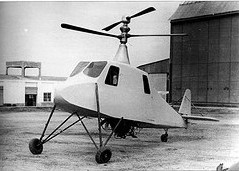Libélula Viblandi
| Libélula Viblandi | |
|---|---|

|
|
| Type: | helicopter |
| Design country: | |
| Manufacturer: | |
| First flight: |
Early 1930 |
The Libélula Viblandi (also known as Libélula española (English: Spanish dragonfly)) was one of the first helicopters with a coaxial rotor drive patented in Spain .
history
The Libélula Viblandi helicopter was developed by the Spanish engineer Federico Cantero Villamil at the beginning of the 20th century . Villamil studied the extraordinary flight apparatus of dragonflies in nature. He had set himself the goal of adopting these capabilities of the natural model with its two pairs of wings, which can move independently of each other, into a mechanical flying machine. He was fascinated by the abrupt change of direction of the dragonflies, which can even stay in the air and fly backwards. He began his experiments with "counter-rotating blades" in Zamora in 1908, and two years later the first process was patented.
Villamil's first helicopter flew in 1924. It was a three-bladed helicopter with a tail rotor.
Further patents on propellers and counter-rotating rotor blade systems were submitted to the Oficina española de patentes y marcas by Federico Cantero Villamil between 1912 and 1936 . As a result of the previous tests and prototypes, Federico Cantero Villamil began to construct the version of the Libélula Viblandi in 1929. The acronym VIBLANDI was derived from the names of those involved: Federico Cantero Vi llamil, Pedro Blan co Pedraza, a young aeronautical engineering student and the owner of the mechanical workshop Antonio Dí az. The drive of the Libélula Viblandi consisted of a rotor arrangement of two main rotors rotating in opposite directions, which were arranged one above the other in an axis of rotation. The gearbox and motor were arranged below the cell. First flight was in early 1930.
In July 1936, when the Spanish Civil War began, the planned series production of the helicopter was interrupted until 1940. In September 1941 the second helicopter with coaxial rotor drive was completed and in October 1941 test flights were carried out with the new version. However, the test results can no longer be adequately proven today. In 1946 Federico Cantero Villamil died in an unknown place and the further construction of helicopters based on the Villamil principle was discontinued. In total, Federico Cantero Villamil had registered 33 patents in the course of the development time for the Libélula Viblandi up to his death.
In 1953 the first series helicopter with the type designation Kamow Ka-15 flew with two main rotors rotating in opposite directions.
literature
- Federico Cantero Villamil: Patentes sobre helicópteros en español. Madrid edición. INTEMAC 2008
- Adolfo Roldán Villén: Libélula Viblandi. Aeroplano. Revista de Historia Aeronáutica. Año 2005. Nº 23rd pp. 28-37
- Federico Suárez Caballero: Federico Cantero Villamil. In Crónica de una voluntad. El Hombre, el Inventor en español (Madrid edición) Arts & Press 2006. ISBN 978-84-934064-1-7
Web links
- El primer helicóptero fue español
- Un catedrático reivindica al pionero español inventor del helicóptero
Individual evidence
- ↑ Patent 1924 Nº 89.824 ( Memento of July 14, 2014 in the Internet Archive )
- ↑ Oficina española de patentes y marcas on historico.oepm.es
- ^ La Libélula Española de Federico Cantero Villamil